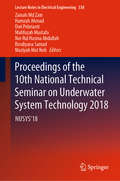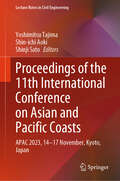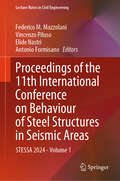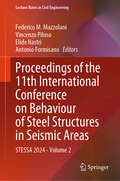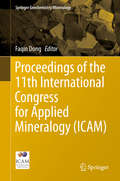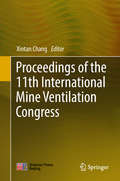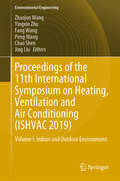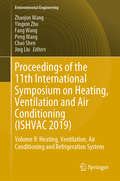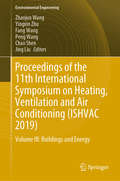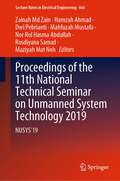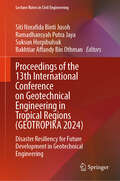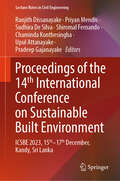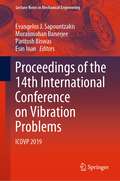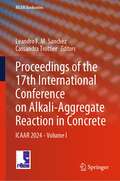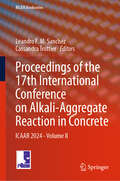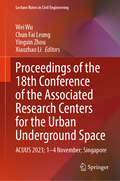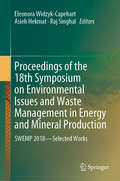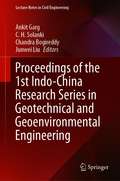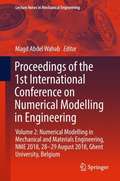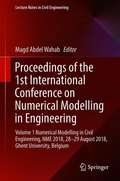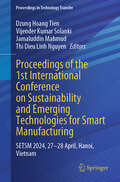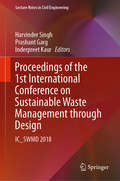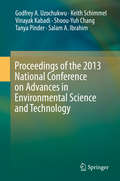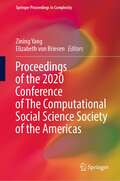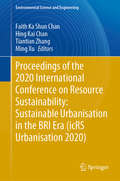- Table View
- List View
Proceedings of the 10th National Technical Seminar on Underwater System Technology 2018: NUSYS'18 (Lecture Notes in Electrical Engineering #538)
by Zainah Md Zain Hamzah Ahmad Dwi Pebrianti Mahfuzah Mustafa Rosdiyana Samad Maziyah Mat Noh Nor Rul AbdullahThis book presents cutting-edge research papers in the field of Underwater System Technology in Malaysia and Asia in general. The topics covered include intelligent robotics, novel sensor technologies, control algorithms, acoustic signal processing, imaging techniques, biomimetic robots, green energy sources, and underwater communication backbones and protocols. The book showcases some of the latest technologies and applications developed to facilitate local marine exploration and exploitation. It also addresses related topics concerning the Sustainable Development Goals (SDG) outlined by the United Nations.
Proceedings of the 11th International Conference on Asian and Pacific Coasts: APAC 2023, 14–17 November, Kyoto, Japan (Lecture Notes in Civil Engineering #394)
by Shinji Sato Yoshimitsu Tajima Shin-Ichi AokiThis book presents peer reviewed articles from the 11th International Conference on Asian and Pacific Coasts (APAC 2023). APAC aims to promote academic and technological progress and activities, international technical transfer and cooperation, and opportunities for engineers and researchers to maintain and improve scientific and technical competence in the field of coastal engineering and related fields, among Asian and Pacific countries/regions. Besides coastal engineering, related fields include but not limited to coastal environment, marine ecology, coastal oceanography, and fishery science and engineering. APAC is jointly supported by the Chinese Ocean Engineering Society (COES), the Coastal Engineering Committee of the Japan Society of Civil Engineers (JSCE), and the Korean Society of Coastal and Ocean Engineers (KSCOE).Chapters "OILPARI - a real-time oil transport simulator for marine disaster response: Its functionary, update, and progresstoward the next generation, "Application of Building Cube Method to reproduce high-resolution hydrodynamics of a dredged borrow pit in Osaka Bay, Japan" and "Geographical Distribution and Recent Change in the Meteorological Event Causing the Annual Maximum Wave Height and Storm Surge around Japan" are available open access under a Creative Commons Attribution 4.0 International License via link.springer.com.
Proceedings of the 11th International Conference on Behaviour of Steel Structures in Seismic Areas: STESSA 2024 - Volume 1 (Lecture Notes in Civil Engineering #519)
by Federico M. Mazzolani Vincenzo Piluso Elide Nastri Antonio FormisanoThis volume highlights the latest advances, innovations, and applications in the field of seismic design and performance of steel structures, as presented by leading international researchers and engineers at the 11th International Conference on the Behaviour of Steel Structures in Seismic Areas (STESSA), held in Salerno, Italy, on July 8-10, 2024. It covers a diverse range of topics such as behaviour of structural members and connections, performance of structural systems, mixed and composite structures, energy dissipation systems, self-centring and low-damage systems, assessment and retrofitting, codes and standards, light-gauge systems. The contributions, which were selected by means of a rigorous international peer-review process, present a wealth of exciting ideas that will open novel research directions and foster multidisciplinary collaboration among different specialists.
Proceedings of the 11th International Conference on Behaviour of Steel Structures in Seismic Areas: STESSA 2024 - Volume 2 (Lecture Notes in Civil Engineering #520)
by Federico M. Mazzolani Vincenzo Piluso Elide Nastri Antonio FormisanoThis volume highlights the latest advances, innovations, and applications in the field of seismic design and performance of steel structures, as presented by leading international researchers and engineers at the 11th International Conference on the Behaviour of Steel Structures in Seismic Areas (STESSA), held in Salerno, Italy, on July 8-10, 2024. It covers a diverse range of topics such as behaviour of structural members and connections, performance of structural systems, mixed and composite structures, energy dissipation systems, self-centring and low-damage systems, assessment and retrofitting, codes and standards, light-gauge systems. The contributions, which were selected by means of a rigorous international peer-review process, present a wealth of exciting ideas that will open novel research directions and foster multidisciplinary collaboration among different specialists.
Proceedings of the 11th International Congress for Applied Mineralogy (ICAM)
by Faqin DongThese proceedings comprise the peer-reviewed contributions submitted to the 11th International Congress for Applied Mineralogy (ICAM) held July 5-10, 2013, at the Southwest University of Science and Technology (SWUST) in Mianyang, China. The biennial ICAM is the most important gathering of applied mineralogists, organized every other year by the ICAM-Council. The multidisciplinary research presented in this book will be of interest to scientists and professionals dealing with topics like environmental and medical mineralogy; industrial minerals; bio-minerals and biomaterials; advanced materials; process mineralogy; mining and metallurgy; cultural heritage; the interaction of minerals with microorganisms; and solid waste treatment and recycling, including genetic mineralogy. "The field of applied mineralogy has been able to match society's pace by continuously reinventing itself, quickly adopting new technologies and instrumentation as they became available and putting them to work for the service of mankind living in a world that heavily relies on minerals. Over the past few decades, applied mineralogy has evolved into a cutting- edge discipline that leads the way for science, engineering and research and development to benefit society. Contrary to popular belief, mineral resources are limited, and we have an obligation to our heirs to use them responsibly. " Dr. Maarten A. T. M. Broekmans Post-President ICAM Council
Proceedings of the 11th International Mine Ventilation Congress
by Xintan ChangThe proceedings of the 11th International Mine Ventilation Congress (11th IMVC), is focused on mine ventilation, health and safety and Earth science. The IMVC has become the most influential international mine ventilation event in the world, and has long been a popular forum for ventilation researchers, practitioners, academics, equipment manufacturers and suppliers, consultants and government officials around the globe to explore research results, exchange best practices, and to launch new products for a better and safer industry. It also serves as a useful platform to attract and train future ventilation professionals and mine planning engineers, as well as for mining companies to discover better practices to provide better ventilation planning.
Proceedings of the 11th International Symposium on Heating, Ventilation and Air Conditioning: Volume I: Indoor and Outdoor Environment (Environmental Science and Engineering)
by Jing Liu Fang Wang Peng Wang Yingxin Zhu Zhaojun Wang Chao ShenThis book presents selected papers from the 11th International Symposium on Heating, Ventilation and Air Conditioning (ISHVAC 2019), with a focus on HVAC techniques for improving indoor environment quality and the energy efficiency of heating and cooling systems. Presenting inspiration for implementing more efficient and safer HVAC systems, the book is a valuable resource for academic researchers, engineers in industry, and government regulators.
Proceedings of the 11th International Symposium on Heating, Ventilation and Air Conditioning: Volume II: Heating, Ventilation, Air Conditioning and Refrigeration System (Environmental Science and Engineering)
by Jing Liu Fang Wang Peng Wang Yingxin Zhu Zhaojun Wang Chao ShenThis book presents selected papers from the 11th International Symposium on Heating, Ventilation and Air Conditioning (ISHVAC 2019), with a focus on HVAC techniques for improving indoor environment quality and the energy efficiency of heating and cooling systems. Presenting inspiration for implementing more efficient and safer HVAC systems, the book is a valuable resource for academic researchers, engineers in industry, and government regulators.
Proceedings of the 11th International Symposium on Heating, Ventilation and Air Conditioning: Volume III: Buildings and Energy (Environmental Science and Engineering)
by Jing Liu Fang Wang Peng Wang Yingxin Zhu Zhaojun Wang Chao ShenThis book presents selected papers from the 11th International Symposium on Heating, Ventilation and Air Conditioning (ISHVAC 2019), with a focus on HVAC techniques for improving indoor environment quality and the energy efficiency of heating and cooling systems. Presenting inspiration for implementing more efficient and safer HVAC systems, the book is a valuable resource for academic researchers, engineers in industry, and government regulators.
Proceedings of the 11th National Technical Seminar on Unmanned System Technology 2019: NUSYS'19 (Lecture Notes in Electrical Engineering #666)
by Zainah Md Zain Hamzah Ahmad Dwi Pebrianti Mahfuzah Mustafa Nor Rul Hasma Abdullah Rosdiyana Samad Maziyah Mat NohThis book includes research papers from the 11th National Technical Symposium on Unmanned System Technology. Covering a number of topics, including intelligent robotics, novel sensor technology, control algorithms, acoustics signal processing, imaging techniques, biomimetic robots, green energy sources, and underwater communication backbones and protocols, it will appeal to researchers developing marine technology solutions and policy-makers interested in technologies to facilitate the exploration of coastal and oceanic regions.
Proceedings of the 13th International Conference on Geotechnical Engineering in Tropical Regions: Disaster Resiliency for Future Development in Geotechnical Engineering (Lecture Notes in Civil Engineering #639)
by Siti Norafida Binti Jusoh Ramadhansyah Putra Jaya Suksun Horpibulsuk Bakhtiar Affandy Bin OthmanThis book presents selected papers from the 13th International Conference on Geotechnical Engineering in Tropical Regions (GEOTROPIKA), held during 4-5 September, in Kuala Lumpur, Malaysia. The book explores the critical intersection of geotechnics in the face of natural disasters. Focused on building resilient infrastructure, the book delves into innovative strategies, technologies, and methodologies to enhance disaster preparedness and recovery. It focuses on issues such as heavy rainfall, expansive soils, and complex geological conditions. Drawing on case studies and cutting-edge research, it provides a comprehensive guide for engineers and policymakers, emphasizing sustainable solutions for mitigating the impact of disasters on geotechnical systems. This timely book serves as a roadmap for fostering resilient communities and advancing future development in the fields of geotechnical engineering.
Proceedings of the 14th International Conference on Sustainable Built Environment: ICSBE 2023, 15th–17th December, Kandy, Sri Lanka (Lecture Notes in Civil Engineering #517)
by Ranjith Dissanayake Priyan Mendis Sudhira De Silva Shiromal Fernando Chaminda Konthesingha Pradeep Gajanayake Upul AttanayakeThis book highlights the latest knowledge and innovations in the fields of civil engineering and construction industry striving for a sustainable built environment. This book consists of high-quality innovative research findings selected from the proceedings of the 14th International Conference on Sustainable Built Environment (ICSBE 2023) under the themes of Sustainable construction, urban green infrastructure and planning, rainwater harvesting and water conservation, high-performance concrete, indoor environmental quality and indoor plants, wind and hydro-power energy, waste and wastewater management for enhanced sustainability, impacts of climate change, carbon footprint, global climate model and landscaping, material flows and industrial ecology, sustainable materials, etc.
Proceedings of the 14th International Conference on Vibration Problems: ICOVP 2019 (Lecture Notes in Mechanical Engineering)
by Paritosh Biswas Esin Inan Evangelos J. Sapountzakis Muralimohan BanerjeeThis book presents the select proceedings of the 14th International Conference on Vibration Problems (ICOVP 2019) held in Crete, Greece. The volume brings together contributions from researchers working on vibration related problems in a wide variety of engineering disciplines such as mechanical engineering, wind and earthquake engineering, nuclear engineering, aeronautics, robotics, and transport systems. The focus is on latest developments and cutting-edge methods in wave mechanics and vibrations, and includes theoretical, experimental, as well as applied studies. The range of topics and the up-to-date results covered in this volume make this interesting for students, researchers, and professionals alike.
Proceedings of the 17th International Conference on Alkali-Aggregate Reaction in Concrete: ICAAR 2024 - Volume I (RILEM Bookseries #49)
by Leandro F. M. Sanchez Cassandra TrottierThis book gathers the peer-reviewed papers presented at the 17th International Conference on Alkali-Aggregate Reaction in Concrete (ICAAR), held in Ottawa, Ontario, Canada, on May 19-24, 2024. It highlights the latest advances and innovations in the field of internal swelling reactions, particularly alkali-aggregate reaction (AAR), and combined mechanisms such as delayed ettringite formation (DEF). The conference topics encompass understanding the reaction mechanisms and the affecting factors; testing methods and preventative measures; diagnosis, evaluation, and prognosis; monitoring and NDT; structural effects and modeling at all scales; repair and remedial measures; and combined mechanisms (e.g., DEF). The contributions, which were selected by means of a rigorous international peer-review process, present a wealth of exciting ideas that will open novel research directions and foster new multidisciplinary collaborations.
Proceedings of the 17th International Conference on Alkali-Aggregate Reaction in Concrete: ICAAR 2024 - Volume II (RILEM Bookseries #50)
by Leandro F. M. Sanchez Cassandra TrottierThis book gathers the peer-reviewed papers presented at the 17th International Conference on Alkali-Aggregate Reaction in Concrete (ICAAR), held in Ottawa, Ontario, Canada, on May 19–24, 2024. It highlights the latest advances and innovations in the field of internal swelling reactions, particularly alkali-aggregate reaction (AAR), and combined mechanisms such as delayed ettringite formation (DEF). The conference topics encompass understanding the reaction mechanisms and the affecting factors; testing methods and preventative measures; diagnosis, evaluation, and prognosis; monitoring and NDT; structural effects and modeling at all scales; repair and remedial measures; and combined mechanisms (e.g., DEF). The contributions, which were selected by means of a rigorous international peer-review process, present a wealth of exciting ideas that will open novel research directions and foster new multidisciplinary collaborations.
Proceedings of the 18th Conference of the Associated Research Centers for the Urban Underground Space: ACUUS 2023; 1–4 November; Singapore (Lecture Notes in Civil Engineering #471)
by Wei Wu Xiaozhao Li Yingxin Zhou Chun Fai LeungThis book presents peer-reviewed articles from the 18th Conference of the Associated Research Centers for the Urban Underground Space (ACUUS 2023) held in Singapore from November 1 to 4, 2023. It highlights new opportunities and challenges in underground space use amid a re-focus on exploring and developing the underground space as a strategic resource and part of sustainable development. The new frontier presents unprecedented opportunities for simultaneously improving urban infrastructure, urban livability, and resilience. At the same time, special challenges exist in developing underground space—both from a human design perspective and in terms of complexity, 3D planning, system integration, technical, and life cycle costs. Equally important is the need to move from the creation of underground space as a haphazard, last resort solution to a well-planned, and integrated use of underground space that can serve the needs of society for future generations as well as our own. As the world emerges from the COVID-19 pandemic and is faced with the many challenges in climate resilience, the works presented in this book provide a timely opportunity and an excellent forum for engaging discussions and exchanges among planners, designers, engineers, researchers, and policy makers.
Proceedings of the 18th Symposium on Environmental Issues and Waste Management in Energy and Mineral Production: SWEMP 2018—Selected Works
by Raj Singhal Eleonora Widzyk-Capehart Asieh HekmatThe research papers presented in these proceedings volumes cover the latest developments and findings in the fields of mine health, safety, energy, waste management,reclamation and rehabilitation, mine closure and environmental protection.Authors from over 20 countries with backgrounds in chemistry, engineering, technology and management, and hailing from the government, industry and academia, have contributed to this book.The contents of this book will be of interest to scientists, engineers, consultants and government personnel who are responsible for the development and implementation of innovative approaches, techniques and technologies in the minerals industries. It will also benefit academic researchers, as it addresses the latest advances in fundamental research.
Proceedings of the 1st Indo-China Research Series in Geotechnical and Geoenvironmental Engineering (Lecture Notes in Civil Engineering #123)
by Ankit Garg C. H. Solanki Chandra Bogireddy Junwei LiuThis book is a compilation of selected papers from the 1st Indo-China Research Series in Geotechnical and Geoenvironmental Engineering held in May 2020 online. The webinar series was held at a time of COVID-19 pandemic, when there is lack of physical connectivity. The cutting-edge research topics in Civil and Environmental Engineering ranging from bio-geotechnology, methane gas hydrates, frozen soils, rock testing, and related high-rise buildings response under wind loading will be covered. The contents make valuable contributions to academic researchers and engineers in the industry and provide a platform for demonstrating joint research between scientists from India and China. These are the first proceedings of its kind to demonstrate and motivate more joint research cooperation in Civil and Environmental Engineering between two countries. It was done mainly to motivate youth research scholars to understand each other and develop long-term cooperation.
Proceedings of the 1st International Conference on Numerical Modelling in Engineering: Volume 1 Numerical Modelling In Civil Engineering, Nme 2018, 28-29 August 2018, Ghent University, Belgium (Lecture Notes in Civil Engineering #20)
by Magd Abdel WahabThis book gathers outstanding papers on numerical modeling in Mechanical Engineering (Volume 2) as part of the proceedings of the 1st International Conference on Numerical Modeling in Engineering (NME 2018), which was held in Ghent, Belgium. The overall objective of the conference was to bring together international scientists and engineers in academia and industry from fields related to advanced numerical techniques, such as the finite element method (FEM), boundary element method (BEM), isogeometric analysis (IGA), etc., and their applications to a wide range of engineering disciplines. This book addresses various industrial engineering applications of numerical simulations to Mechanical and Materials Engineering, including: Aerospace applications, Acoustic analysis, Biomechanical applications, Contact problems and wear, Heat transfer analysis, Vibration and dynamics, Transient analysis, Nonlinear analysis, Composite materials, Polymers, Metal alloys, Fracture mechanics, Fatigue of materials, Creep behavior, Phase transformation, and Crystal plasticity.
Proceedings of the 1st International Conference on Numerical Modelling in Engineering: Volume 1 Numerical Modelling in Civil Engineering, NME 2018, 28-29 August 2018, Ghent University, Belgium (Lecture Notes in Civil Engineering #20)
by Magd Abdel WahabThis book contains manuscripts of topics related to numerical modeling in Civil Engineering (Volume 1) as part of the proceedings of the 1st International Conference on Numerical Modeling in Engineering (NME 2018), which was held in the city of Ghent, Belgium. The overall objective of the conference is to bring together international scientists and engineers in academia and industry in fields related to advanced numerical techniques, such as FEM, BEM, IGA, etc., and their applications to a wide range of engineering disciplines. This volume covers industrial engineering applications of numerical simulations to Civil Engineering, including: Bridges and dams, Cyclic loading, Fluid dynamics, Structural mechanics, Geotechnical engineering, Thermal analysis, Reinforced concrete structures, Steel structures, Composite structures.
Proceedings of the 1st International Conference on Sustainability and Emerging Technologies for Smart Manufacturing: SETSM 2024, 27–28 April, Hanoi, Vietnam (Proceedings in Technology Transfer)
by Vijender Kumar Solanki Thi Dieu Linh Nguyen Dzung Hoang Tien Jamaluddin MahmudThis book presents peer-reviewed articles from the 1st International Conference on Sustainability and Emerging Technologies for Smart Manufacturing (SETSM 2024) held on 27–28 April at Hanoi in Vietnam. It includes the latest research and innovations in Sustainability and emerging technologies for Smart Manufacturing and Industry 4.0, especially innovative solutions for development of sustainable and smart eco-systems for a wide range of applications in industries, health care, and medicine.
Proceedings of the 1st International Conference on Sustainable Waste Management through Design: IC_SWMD 2018 (Lecture Notes in Civil Engineering #21)
by Harvinder Singh Prashant Garg Inderpreet KaurThis book describes the latest advances, innovations and applications in the field of waste management and environmental geomechanics as presented by leading researchers, engineers and practitioners at the International Conference on Sustainable Waste Management through Design (IC_SWMD), held in Ludhiana (Punjab), India on November 2-3, 2018. Providing a unique overview of new directions, and opportunities for sustainable and resilient design approaches to protect infrastructure and the environment, it discusses diverse topics related to civil engineering and construction aspects of the resource management cycle, from the minimization of waste, through the eco-friendly re-use and processing of waste materials, the management and disposal of residual wastes, to water treatments and technologies. It also encompasses strategies for reducing construction waste through better design, improved recovery, re-use, more efficient resource management and the performance of materials recovered from wastes. The contributions were selected by means of a rigorous peer-review process and highlight many exciting ideas that will spur novel research directions and foster multidisciplinary collaboration among different waste management specialists.
Proceedings of the 2013 National Conference on Advances in Environmental Science and Technology
by Vinayak Kabadi Shoou-Yuh Chang Keith Schimmel Godfrey A. Uzochukwu Tanya Pinder Salam A. IbrahimThis book contains peer reviewed papers accepted for presentation at the National Conference on Advances in Environmental Science & Technology. Topics include environmental regulations, groundwater remediation technologies, waste to energy, climate change, economics, environmental justice, fate and transport of contaminants, food bio-processing, innovative environmental technologies, sustainable energy and water resources and waste management. Federal agencies, private agencies and university professors set the stage for the September 12, 2013 National Conference on Advances in Environmental Science and Technology. The purpose of the National Conference on Advances in Environmental Science and Technology which was held in Greensboro, North Carolina, was to provide a forum for agencies to address advances in environmental science and technology including problems, solutions and research needs.
Proceedings of the 2020 Conference of The Computational Social Science Society of the Americas (Springer Proceedings in Complexity)
by Zining Yang Elizabeth Von BriesenThis book is comprised of the latest research into CSS methods, uses, and results, as presented at the 2020 annual conference of the Computational Social Science Society of the Americas (CSSSA). Computational social science (CSS) is the science that investigates social and behavioral dynamics through social simulation, social network analysis, and social media analysis. The CSSSA is a professional society that aims to advance the field of computational social science in all areas, including basic and applied orientations, by holding conferences and workshops, promoting standards of scientific excellence in research and teaching, and publishing research findings and results. The above-mentioned conference was held virtually, October 8 – 11, 2020. What follows is a diverse representation of new results and approaches to using the tools of CSS and agent-based modeling (ABM) in exploring complex phenomena across many different domains. Readers will therefore not only have the results of these specific projects upon which to build, along with a wealth of case-study examples that can serve as meaningful exemplars for new research projects and activities, they will also gain a greater appreciation for the broad scope of CSS.
Proceedings of the 2020 International Conference on Resource Sustainability: Sustainable Urbanisation in the BRI Era (Environmental Science and Engineering)
by Hing Kai Chan Tiantian Zhang Ming Xu Faith Ka Shun ChanThis book focuses on the latest cutting-edge research for achieving sustainable development goals during urbanisation in the Belt and Road Initiative Era. The book aims on tackling urban challenges on social and environmental issues. The book is a compilation of selected papers from the 2020 International Conference on Resource Sustainability – Sustainable Urbanisation in the BRI Era (icRS Urbanisation 2020). The contents make valuable contributions to academic researchers, practitioners in the industry and policymakers of respective authorities. Readers will also encounter new ideas for realising a better sustainable development for urbanisation.
